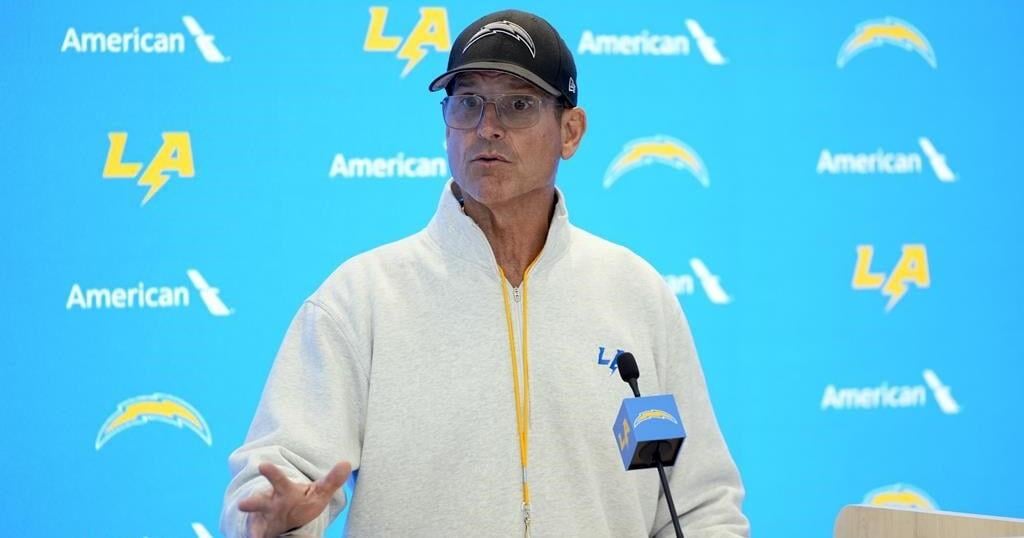ANN ARBOR, Mich. (AP) — The NCAA announced a four-year, show-cause order for former Michigan coach Jim Harbaugh on Wednesday for impermissible contact with recruits and players during the COVID-19 pandemic, effectively banning him from college athletics until August 2028.
The NCAA said Harbaugh, who left his alma mater to coach the Los Angeles Chargers after last season’s undefeated national championship, “failed to promote an atmosphere of compliance and violated head coach responsibility obligations.”
“Harbaugh engaged in unethical conduct and failed to cooperate when he denied any involvement in impermissible recruiting contacts despite substantial information to the contrary,” the NCAA said in a 48-page decision that several times suggested the coach was not truthful with investigators.
Harbaugh will only face the punishment if he makes an unexpected return to college football within the next four years.
The recruiting case is unrelated to the NCAA’s investigation into impermissible in-person scouting and sign-stealing allegations that roiled Michigan’s championship season in 2023 and resulted in a three-game suspension of Harbaugh by the Big Ten Conference.
Multiple infractions cases in such a short time period could prompt the NCAA to treat Michigan as a repeat offender, opening the school up to harsher penalties in the sign-stealing case.
“It probably just matters more in terms of how the committee (on infractions) interprets the entire case and whether they’re giving the institution the benefit of the doubt in some areas,” said Jay Ezelle, an attorney based in Birmingham, Alabama, who has handled NCAA cases.
New Michigan coach Sherrone Moore is facing allegations he violated NCAA rules related to the investigation into scouting and sign-stealing, three people briefed on a pending notice of allegations told The Associated Press last weekend. All spoke on condition of anonymity because the notice was confidential.
Two of the people said Moore has been accused of deleting text message exchanges with Connor Stalions — the former low-level recruiting staffer who coordinated an off-campus, advance-scouting operation — around the time the investigation was opened.
One of the people said the NCAA has recommended a less serious Level 2 violation for Moore, adding that messages between Moore and Stalions were recovered and that the coach provided them to the NCAA.
The NCAA had already put Michigan on three years of probation along with a fine and recruiting limits after reaching a negotiated resolution in the case. Harbaugh did not go along with the agreement, contesting allegations he failed to cooperate with investigators, and his case was handled separately.
The committee on infractions noted that Harbaugh’s “intentional disregard” for NCAA rules amplified the severity of the case and prompted the panel to classify Harbaugh’s case as Level I-aggravated, leading to a one-year suspension as part of the show-cause order.
The order runs through Aug. 6, 2028. It requires any school wanting to hire Harbaugh over the next four years to suspend him for the first full season. After that, Harbaugh would be still be barred from athletics-related activities, including team travel, practice, video study, recruiting and team meetings until the order expires.
Harbaugh’s attorney, Tom Mars, has said the coach was not invited to participate in the settlement process nor was he aware that an agreement had been reached between the school and the NCAA. He blasted the NCAA’s punishment.
“The way I see it, from Coach Harbaugh’s perspective, today’s COI decision is like being in college and getting a letter from your high school saying you’ve been suspended because you didn’t sign your yearbook,” Mars posted on social media. “If I were in Coach Harbaugh’s shoes and had an $80 million contract as head coach of the Chargers, I wouldn’t pay any attention to the findings of a kangaroo court which claims to represent the principles of the nation’s most flagrant, repeat violator of the federal antitrust laws.”
Michigan athletic director Warde Manuel noted the school has already accepted the sanctions and served many of the penalties.
“Our staff has worked to improve processes and we are focused on the future and our commitment to integrity and compliance,” Manuel said.
Moore, who was promoted from offensive coordinator to head coach when Harbaugh bolted for the Chargers, filled in as acting head coach four times last season while Harbaugh served suspensions, including the regular-season finale against Ohio State.
In-person scouting is banned by the NCAA, which investigated Michigan’s alleged system to determine how organized it was and who knew about it. Stalions, who has not cooperated with the NCAA in its investigation, will break his silence Aug. 27 on Netflix when the documentary “Sign Stealer” makes its debut on the streaming service.
“I do not apologize,” Harbaugh said Monday when asked about the NCAA’s sign-stealing notice to the Wolverines. “I did not participate. I was not aware nor complicit in those said allegations.”
In the recruiting case, the NCAA sharply questioned Harbaugh’s “vague” responses during interviews with investigators, at one point “asking whether he was lying to the enforcement staff.”
“I do not think I’m providing false or misleading information,” Harbaugh replied.
The NCAA noted that Harbaugh could not recall meeting with recruits despite confirmation from at least one of his own staff members and the prospects’ families. One recruit specifically remembered the coach “ordered a hamburger for breakfast, which ‘kind of stood out’ to him.” Other NCAA evidence included a text message from Harbaugh to a recruit.
“Given the significant amount of reasonable, credible information in the record, Harbaugh’s denials are not credible,” the NCAA said.
Harbaugh’s punishment and news about the sign-stealing scandal all come with Michigan ramping up to the defend its national title. The Wolverines open the season at home against Fresno State on Aug. 31.
“Once you’re at the top, things like that happen,” Michigan defensive back Quinten Johnson said a few hours before the announcement of penalties against Harbaugh. “That’s not really a concern right now.”
___
AP College Football Writer Ralph D. Russo contributed. Follow Larry Lage at https://twitter.com/larrylage
___
AP college football: and

























